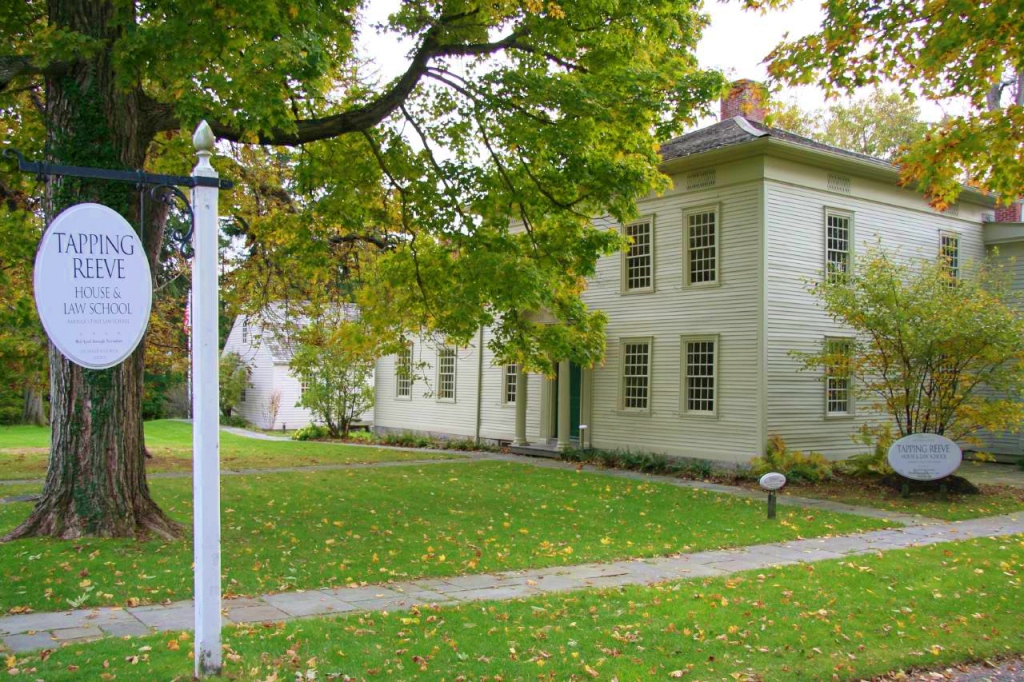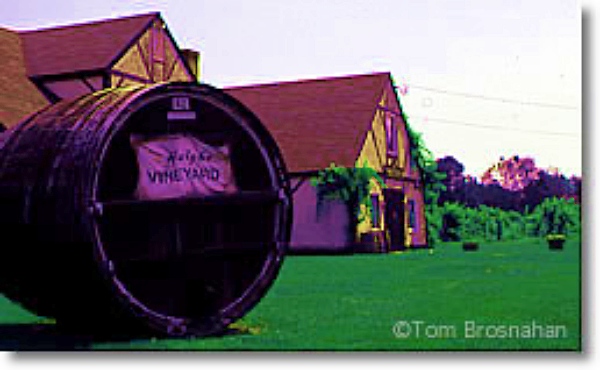Western Connecticut Guide
Escape to this beautiful, rural, historic area with pretty old towns, covered bridges, glacial lakes, little vineyards, and the foothills of the Berkshire Hills.
Lake Waramaug, near New Preston in northwestern Connecticut.
Northwest of Hartford, Connecticut is beautiful country of rolling hills, forests, farms and lakes.
Where to Stay
Lodgings are not as plentiful here as in larger towns and cities, so use this Hotel Map with Prices centered on nearby Torrington to locate a place that will fit your travel route:
Litchfield
Litchfield, Connecticut's answer to the pretty Massachusetts towns in the Berkshire Hills, was incorporated in 1719, and in the next 100 years it grew and prospered as a center for small industry and an important way station on the Hartford-Albany stagecoach route.
With this prosperity came the wherewithal, and the urge, to build fine, graceful houses, which is what the citizens did, making sure that the houses were set well back from the road.
Progress in other towns during the 19th century robbed Litchfield of much of its wealth—water-powered industry in river towns drove Litchfield's small-time craftsmen out of business, and the railroads bypassed the town.
But the town's decline may have been a blessing in disguise, at least for later generations.
Today Litchfield retains its late 18th-century beauty, unsullied by the workers' tenements and textile mills that have changed the face of so many other New England towns. A National Park Service writer has called Litchfield "probably New England's finest surviving example of a typical late 18th-century town."
A pleasant morning or afternoon can be spent driving from New York City, Hartford or the Berkshires to Litchfield.
Litchfield county, surrounding the town of Litchfield, is all forest, rivers, and rolling hills, some of the prettiest country in this exceptionally pretty state.
Litchfield has few places to stay overnight...by choice. Its citizens prefer visitors to come for the day and disappear at night, so unless you can find a room at The Litchfield Inn you will probably have to find lodging elsewhere.
What to See & Do
America's first law school, the birthplace of Vermont Revolutionary War hero Ethan Allen, a pretty town green and a good small historical museum are worth your time in Litchfield.
Drive down South Street to get the feel for this gracious neighborhood. Park your car near the town green, walk around to admire the fine old houses, visit the Tapping Reeve House and Law School, America's first law school, and take a winery tour at Haight-Brown Vineyards.
Tapping Reeve House & Litchfield Law School
The small, unprepossessing edifice beside the house at 82 South Street was America's first school of law, established here by in 1775. Mr Tapping Reeve (1744-1823), recently married to Sarah ("Sally") Burr, the sister of Aaron Burr, moved to the thriving New England town of Litchfield, Connecticut in 1773 to take up the practice of law.

Tapping
Reeve House and Law School—the
first law school in the USA.
At the time, the American colonies had no school of law. Those wishing to learn the law were taught by other lawyers, so in 1774, Aaron Burr, who Reeve had taught in grammar school, moved to Litchfield to live with Sally Burr Reeve and Tapping Reeve to learn the law.
Other young men followed, and in time the number of students exceeded the capacity of the law office in Reeve's house. In 1784 he had the law school building next door to his home.
Between 1774 and 1833, when the school closed, over 1100 students came to Litchfield to study at the Tapping Reeve School of Law. Among them were 128 young men who went on to become US senators and congressmen, two vice-presidents of the United States, three justices of the Supreme Court, fourteen state governors, and many others who had prominent legal careers in commerce, industry and government.
Tapping Reeve's lectures, organized into an 18-month course of instruction, became the gold standard for legal practice in the young United States of America. The notes that his students took during the lectures became the foundation for the law libraries in their offices, and the legal reference-works of their time.
If you have any interest in the law, or in the early history of the United States, the Tapping Reeve House and Law School is a worthy place to visit, open mid-April through November (closed Sunday).
Litchfield History Museum
Interested in the history of Litchfield? Make the short stroll across the town green to the Litchfield History Museum, 7 South Street, for a broader look.
Admission to the museum is free.
The exhibits offer an interesting glimpse of the town's past politics, economy, industry, and art, recorded in diagrams, documents, furniture, historic clothing, and artifacts.
Prime of place in the museum's seven galleries are exhibits dedicated to Litchfield's most prosperous period, the 50 years following the American Revolution.
Ethan Allen House
Thought to be the one in which the famous patriot and leader of Vermont's "Green Mountain Boys" was born, in 1738, it's 272 South Street, at the southern end of South Street, in the road's fork. A private home, it's not open to visits.
North Street
Heading north from the town green, it's lined with fine old houses, many from the 18th and 19th centuries.
West Street
A milestone dating from 1787, which informed the traveler that it was "33 Miles to Hartford, 102 Miles to New York—J. Strong AD 1787," stands on West Street, northern side, just at the end of the town green.
Litchfield Jail
Right on the green at the beginning of North Street,the old jail—once conveniently connected to the bank next door—is now used as a halfway house for women re-entering society after difficult life experiences.
White Memorial Conservation Center
Connecticut's largest nature center has over 35 miles (56 km) of walking trails, campsites, and several prime perches for birdwatching, just outside Litchfield at 80 Whitehall Road.
Trails at the White Memorial Conservation Center, on US Route 202 just outside of Litchfield towards Bantam, are open for free to hikers, mountain/trail bikers, horseback riders, and corss-country skiers, all year round.
The Center also has a museum with dioramas, mounted specimens, live animals, a touch center, and a 4000-volume nature library which includes a children's room.
There's a small admission fee for the museum.
Windmill Hill Family Campground has 18 campsites, and Point Folly Family Campground, on a peninsula in Bantam Lake, has 47 campsites. Sites in both campgrounds must be reserved in advance, and a fee paid.
Haight-Brown Vineyards
A mile east of Litchfield, this quaint place prides itself on being Connecticut's first farm winery. This quaint and inviting place prides itself on being Connecticut's first farm winery (established 1975). Come for a vineyard tour and wine tasting, 29 Chestnut Hill Road off CT Route 118, a mile east of Litchfield.

Haight-Brown Vineyard near Litchfield,
Connecticut's first farm winery.
You can also take the Vineyard Walk, a self-guided tour of the vineyards during which you can inspect the types of grapes which make Haight-Brown wines.
Salisbury
In the charming old town of Salisbury, you're only 4 miles from the Massachusetts state line, and 12 miles from the southern Berkshire Hills town of South Egremont (map). It's a fine old town at the uppermost corner of northwestern Connecticut, with lots of antiques.
Salisbury is an aristocratic, historic Connecticut town (population 4000) at the southern end of the range of low mountains that, in Massachusetts to the north, are called the Berkshire Hills.
The villages of Lakeville and Lime Rock (with its auto racetrack) are within the township of Salisbury, and the Appalachian Trail runs through the town.
Housatonic Meadows State Park is north of Salisbury US Route 7, with camping and picnic areas.
Late in September there's a big flea market in Salisbury, and at the height of the fall foliage season the Salisbury Antiques Fair is held in the Town Hall.
Come any time of year, though. The town is pretty, tranquil, surrounded by gorgeous country, and only 20 miles from the heart of the Berkshire Hills' summer and winter activities.
Stay in nearby Cornwall Bridge, famous for its picturesque covered bridge, if you like, and consider a short trip to Lakeville for a meal.
Iron ore was discovered here in 1728, and the town, incorporated in 1741, soon became noted for the quality of its wought iron. The Connecticut arms manufacturers were major customers for Salisbury iron.
Lake Waramaug
Western Connecticut is sprinkled with pretty glacial lakes. Lake Waramaug, near New Preston (map) in Lake Waramaug State Park is the prettiest, with fine inns, a vineyard and a state park on its shores.
Lake Waramaug from the state
park beach and picnic area.
Named for an Indian chief of the Wyantenock people, Lake Waramaug is a fine destination for a swim, a picnic stop, a day's outing, or even an overnight in a tent or an inn—especially in foliage season, when its trees are ablaze with color.
To stay overnight here in summer, you've got to plan your visit and make reservations for accommodations, as they are relatively few, and fill early.
Lake Waramaug State Park
Stop for sure at 95-acre (38-hectare) Lake Waramaug State Park for a swim, a picnic, some lake fishing, or a snooze on the grassy lawns. The drive around the lake can be done in less than an hour if you don't stop—but stopping is the whole point!
Stop for a meal, afternoon tea, a drink or overnight at one of the inns (Hopkins Inn, Lakeview Inn, or The Boulders).
If you want to camp, you must reserve one of the 88 good lakeside tent campsites in advance.
If you don't find a campsite available here, you can try at Housatonic Meadows State Park, two miles (3 km) north in Cornwall Bridge/Sharon; or Macedonia Brook State Park in Kent. Kent Falls State Park and Mount Tom State Park are also near, and offer fishing, hiking and picnicking, but no camping.
Cornwall Bridge
North on CT Route 45 is the town of Cornwall Bridge, named for its pretty old-fashioned red covered bridge, with a stop and a photo.
Taste some of the wines made from French-American hybrid grapes at the Hopkins Vineyard on Hopkins Road in Warren CT.

